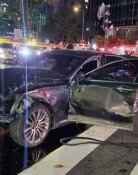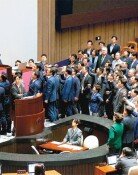Labor Day Rallies Abound Albeit Peacefully
Labor Day Rallies Abound Albeit Peacefully
Posted May. 01, 2003 22:15,
At Munhwa Square in Yoido, Seoul at 9:30 a.m. on May 1, some 1,000 union members gathered to attend a Labor Day event organized by the Federation of Korean Trade Unions (FKTU).
Yet, the way they dressed and the mood was quite different from Labor Day events of years past. Women were wearing jeans and casual shirts or jackets instead of the dark-color uniforms they used to wear on such occasions. Many were also wearing make-up, and looked as though they were enjoying the sunny spring weather.
People were seen saying their hellos to one another across many different union flags. They were talking and smiling at one another. The `Death to Restructuring` phrase on some of the flags looked kind of out of place.
After the official ceremony, FKTU held a `tortoise marathon,` an event aimed to deliver its message of calling for the five-day workweek system and ending discrimination against contract workers.
Come and run together. Get nice souvenirs, Lee Min-woo, policy director of FKTU, shouted at union members at the registration desk.
Until last year, Labor Day events were focused on the struggle for workers` rights, explained Lee Jung-shik, public relations director at the federation. This year, however, we are now at the last stage of government-led restructuring and also see the need to build a new relationship between management and labor parties, which is why we are focusing more on cultural events.
The police only assigned about 100 men at the event. The riot police were napping on their buses.
At Marronnier Square in Dongsung-ro, Seoul at 1:40 p.m. with more than 20,000 showing up, the Labor Day event organized by the Korean Confederation of Trade Unions (KCTU) started with a traditional Korean folk music performance. The event was also filled with songs and dance rather than chanting of slogans.
After the address by KCUT Chairman Dan Byung-ho, people began to march to City Hall. The police did not interfere with the march at all, allowing protestors to maintain order for themselves; this was a first in the history of such rallies.
A police line comprising of policewomen and traffic control officers was posted at intersections with no confrontation, only smiles and mild chanting.
Sung-Kyu Kim kimsk@donga.com







